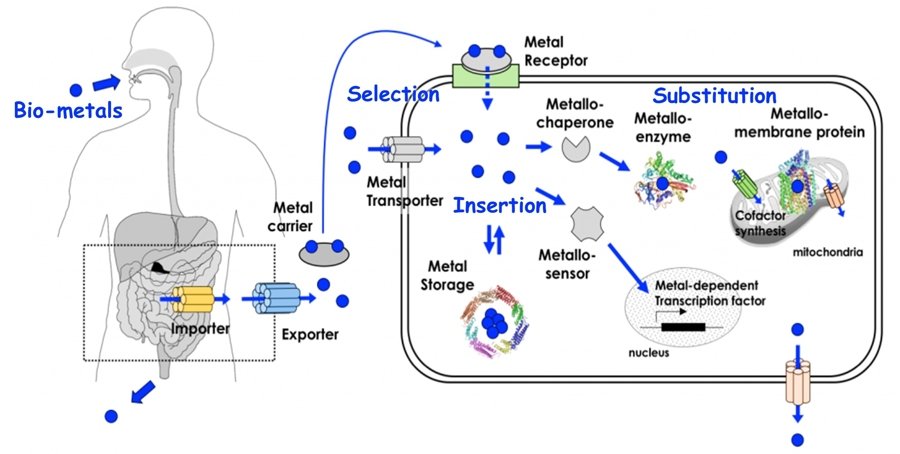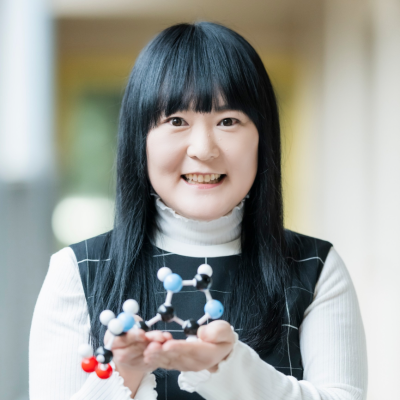Research Theme
Molecular Science of Bio-metal Dynamics: Understanding and regulation of the strategies of metal utilization in living things
Keywords
Metal transporters, metal chaperones, metal ion transfer mechanisms through protein-protein interactions, functional analysis using human intestinal cells
Metals play important roles in living organisms! Our cells are mainly made up of water, proteins, and lipids, but they also contain small amounts of metals that help keep our bodies in good condition. The metal nutrients contained in food are used to reduce toxicity by binding to a wide variety of proteins. In other words, these metals are used as active centers of enzymes that carry out functions essential to sustaining life, e.g. transport and storage of oxygen, energy production, gene synthesis, has been known for many years. However, the series of molecular mechanisms underlying metal dynamics in the body (absorption, sensing, transport, storage, and excretion of metals) and selectivity for individual metals remain unknown. Our group focuses on "iron", which is the most important metal among the essential metals for sustaining the life of living things, focusing on various proteins that play a role in the selective absorption, sensing, and intracellular transport of iron in food. We are not only elucidating the structure of related proteins, but also exploring the relationship with the functions in human cells.

Metal homeostasis in humans
Our aim is to understand the uptake, trafficking, and regulation of "bio-metals" through the relay of protein-protein interactions.
Selected Publications
-
Menega Ganasen, Hiromi Togashi, Hanae Takeda, Honami Asakura, Takehiko Tosha, Keitaro Yamashita, Kunio Hirata, Yuko Nariai, Takeshi Urano, Xiaojing Yuan, Iqbal Hamza, A. Grant Mauk, Yoshitsugu Shiro, Hiroshi Sugimoto, Hitomi Sawai (2018) “Structural basis for promotion of duodenal iron absorption by enteric ferric reductase with ascorbate” Communications Biology, 1, 120. doi: 10.1038/s42003-018-0121-8
-
Gareth S. A. Wright, Akane Saeki, Takaaki Hikima, Yoko Nishizono, Tamao Hisano, Misaki Kamaya, Kohei Nukina, Hideo Nishitani, Hiro Nakamura, Masaki Yamamoto, Svetlana V. Antonyuk, S. Samar Hasnain, Yoshitsugu Shiro, Hitomi Sawai (2018) “Architecture of the complete oxygen-sensing FixL-FixJ two-component signal transduction system” Science Signaling, 11, eaaq0825. doi: 10.1126/scisignal.aaq0825
-
Megumi Nishinaga, Hiroshi Sugimoto, Yudau Nishitani, Seina Nagai, Satoru Nagatoishi, Norifumi Muraki, Takehiko Tosha, Kouhei Tsumoto, Shigetoshi Aono, Yoshitsugu Shiro, Hitomi Sawai (2021) “Heme controls the structural rearrangement of its sensor protein mediating the hemolytic bacterial survival” Communications Biology, 4, 467. doi: 10.1038/s42003-021-01987-5
-
『生命金属ダイナミクス:生体内における金属の挙動と制御』第4章 維持─分子─ 第2節 生体鉄の分子科学と細胞生物学(城 宜嗣、澤井 仁美、當舎 武彦)、エヌ・ティー・エス出版、ISBN: 9784860437060
-
『ヘムタンパク質の科学:生理機能の理解とその展開に向けて』第3章 情報交換:情報伝達に関与するヘムタンパク質 第2節 シグナル分子として機能するヘム(澤井 仁美)/第4章 ヘム輸送とヘム代謝 第3節 金属イオンの取り込みに関与するヘム含有酵素(澤井 仁美)、エヌ・ティー・エス出版、ISBN: 9784860437787



